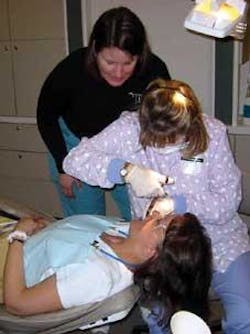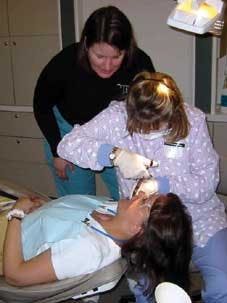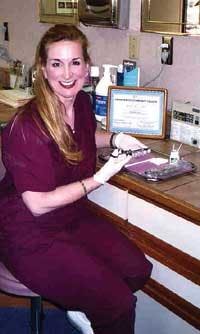Sisters & anesthesia
More than a year has passed since Trish Toma, RDH, has started successfully performing local anesthesia on patients before her non-surgical periodontal therapy procedures. In her state, Michigan, the dental practice acts allow dental hygienists to perform local anesthesia following certification and examination.
Trish is employed by Dr. Patrick L. Sweeney of Lakeshore Periodontics and Dental Implants in East Pointe. Dr. Sweeney is a graduate of the University of Detroit Dental School.
Trish is a graduate of the University of Detroit's dental hygiene program. She was one of the first to take the NERB written examination in local anesthesia after receiving her continuing education certificate. After taking the NERB examination, she was allowed to perform the full range of local anesthesia injections, and, most importantly for dental hygiene treatment, the safer and more effective anesthetic blocks. Trish attended a seminar presented by Margaret Fehrenbach, RDH, MS, who is the primary author of Illustrated Anatomy of the Head and Neck (WB Saunders, 2002).
Trish and Margaret are also sisters.
Margaret is a graduate of the Marquette dental hygiene program and is an adjunct faculty member in charge of the university's online coursework. She currently resides in Seattle and has been enjoying expanded-duty practice since 1981. The seminar was the first time the sisters met as peers and fellow dental hygienists, and they really enjoyed the time together. Their conversations were not only about pain control, new instruments and patient treatment protocol but about family matters as well. "When we get together, it is fun to discuss the latest treatments, me from an oral biology perspective and Trish from a full-time private practice experience," Margaret says.
Margaret frequently works with the director of Canyon Dental Seminars, Julienne Strasser, RDH, in presenting courses for dental hygienists throughout the United States in local anesthesia and nitrous oxide. The courses in pain control feature the "Velvet Touch" approach in patient care. Not only is emphasis placed on correct background in pain control for dental hygiene practice, but also on how it is administered since many dental patients fear pain control procedures.
Julienne's goal is to ensure that seminar participants also feel no fear as they move into a new level of dental hygiene practice. Julienne states, "Learning a new procedure can be unnerving for those hygienists who have been out in practice and away from school for many years. I tell the participants that we strive for a relaxed atmosphere and even have some fun while absorbing the review and application of dental anatomy, pharmaco-dynamics of the drugs and emergency/complications of administering local anesthesia and nitrous oxide/oxygen sedation. Everyone leaves the course exhilarated and confident."
Julienne developed Rock Valley College's dental hygiene program in Rockford, Ill. She also is an examiner for the Northeast Regional Boards and understands the importance for calibration of her instructors for the courses.
Julienne says, "We select our instructors very carefully. We select them not only for their ability to teach but to establish a comfortable learning environment in the clinic for the participants. They are calibrated to ensure the quality of learning for the participants is held at a high level of consistency and accuracy in teaching the Velvet Touch. We strive for a student/instructor ratio of 6/1. It allows individual instruction for each participant."
For Trish, the seminar was mainly a review, since she had performed local anesthesia when she lived in Southern California. She said that the review helped her learn the latest and best ways to approach the procedure. At Dr. Sweeney's busy office, the procedure has meant a workable daily schedule for patients needing non-surgical periodontal therapy.
"I think having Trish as our hygienist who is able to give anesthesia to our patients has been an incredible asset. Patients just love the way that Trish gives anesthetic," Dr. Patrick Sweeney states.
Trish recommends that other hygienists take in this added responsibility and enjoy the full care they can give patients free of pain. Dr. Sweeney adds "Trish, who is an energetic and enthusiastic team member, has definitely enhanced her value to our practice by assuming this added responsibility. I highly recommend that all hygienists pursue this new avenue now available to them."
For information about the certification process behind administering local anesthesia, contact Fehrenbach at [email protected] or Strasser at [email protected] or (815) 492-2319, or visit www.dhed.net.




